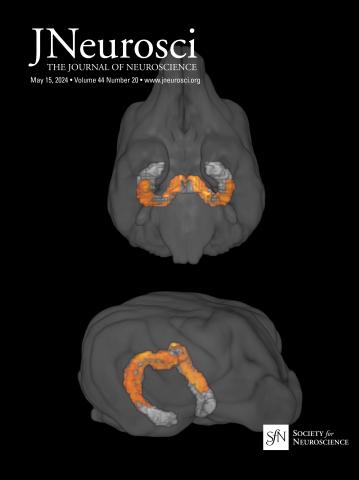The role of the Ca2+-activated Cl- conductance in the membrane potential and light response of mouse rods.
IF 4.4
2区 医学
Q1 NEUROSCIENCES
引用次数: 0
Abstract
To characterize the function of the Ca2+-activated Cl- current ICl(Ca) in mammalian rod photoreceptors, we made patch-clamp recordings from retinal slices of mice (Mus musculus) of both sexes that lack Ano2 (TMEM16B). Depolarizing voltage ramps in solutions blocking K+ currents elicited a large outward current inhibited by the Cl-- channel blocker niflumic acid; this current was absent in Ano2-/- rods. The membrane potential of Ano2-/- rods was 10 - 15 mV more depolarized in darkness than WT or Cx36-/- rods, indicating a substantial resting Cl- permeability. Rod outer segment photocurrents were similar in waveform and amplitude in Ano2-/- and Cx36-/- rods, but photovoltages in Ano2-/- rods were nearly doubled. Measurements of light-response reversal potentials in rods with and without Ano2 suggest that the outer-segment conductance is nearly linear with a reversal potential of -9 mV; and that [Formula: see text] increases during the light response. Using these results, we estimated ECl from permeabilized-patch recordings of reversal potentials of Cx36-/- rods to have a mean value of -35 mV near the rod resting potential, but other evidence suggests that ECl may be more positive by as much as 10 - 15 mV. Thus activation of ICl(Ca) during the light response would be depolarizing. At dim intensities, the photocurrents of downstream rod bipolar cells were larger and about twice as sensitive in Ano2-/- retinas with reduced nonlinearity. These experiments show that Ca2+-activated Cl- currents in mammalian rods have more important roles in photoreceptor physiology than previously appreciated.Significance Statement To characterize the function of the Ca2+-activated Cl- channel in mammalian rods, we recorded from Ano2-/- mice with a disrupted channel gene. We show that these Cl- channels make a surprisingly large contribution to the rod resting permeability. Moreover, measurements of reversal potentials indicate that light produces an increase in Cl- conductance, which can only occur if the Ca2+ concentration near the channels is increasing even as the rod membrane potential is hyperpolarizing. We describe a novel method to make the first measurement of ECl in a mammalian rod, which is near to or somewhat positive of Erest Thus, channel activation would depolarize the rod. Ca2+-activated Cl- channels have more important roles in mammalian photoreceptor physiology than previously appreciated.钙离子激活的Cl-电导在小鼠棒细胞膜电位和光响应中的作用。
为了表征Ca2+激活的Cl-电流ICl(Ca)在哺乳动物杆状光感受器中的功能,我们对缺乏Ano2 (TMEM16B)的雌雄小鼠(小鼠)的视网膜切片进行了膜片钳记录。在阻挡K+电流的溶液中,去极化电压斜坡引发了一个大的向外电流,这被Cl-通道阻滞剂尼氟酸抑制;这种电流在Ano2-/-棒中不存在。在黑暗中,Ano2-/-棒的膜电位比WT或Cx36-/-棒的去极化多10 - 15mv,表明其具有较高的静息Cl-渗透性。在Ano2-/-和Cx36-/-棒中,棒外段光电流波形和幅值相似,但在Ano2-/-棒中光伏几乎翻了一番。在有和没有Ano2的棒中光响应反转电位的测量表明,外段电导几乎是线性的,反转电位为-9 mV;并且[公式:见文本]在光响应期间增加。利用这些结果,我们从Cx36-/-棒的反转电位的渗透贴片记录中估计ECl在棒静息电位附近的平均值为-35 mV,但其他证据表明ECl可能更正10 - 15 mV。因此,在光响应过程中,ICl(Ca)的激活将是去极化的。在微弱的强度下,下游杆双极细胞的光电流更大,在非线性降低的情况下,Ano2-/-视网膜中的灵敏度大约是前者的两倍。这些实验表明,哺乳动物视杆细胞中Ca2+激活的Cl-电流在光感受器生理中具有比以前认识到的更重要的作用。为了表征哺乳动物杆状体中Ca2+激活的Cl-通道的功能,我们记录了带有通道基因中断的Ano2-/-小鼠。我们发现这些Cl-通道对杆的静息渗透率有惊人的巨大贡献。此外,逆转电位的测量表明,光产生Cl-电导的增加,这只能发生在通道附近的Ca2+浓度增加的情况下,即使杆膜电位是超极化的。我们描述了一种新的方法来首次测量哺乳动物杆状细胞的ECl,它接近或有些正的est,因此,通道激活会使杆状细胞去极化。Ca2+激活的Cl-通道在哺乳动物光感受器生理中具有比以前认识的更重要的作用。
本文章由计算机程序翻译,如有差异,请以英文原文为准。
求助全文
约1分钟内获得全文
求助全文
来源期刊

Journal of Neuroscience
医学-神经科学
CiteScore
9.30
自引率
3.80%
发文量
1164
审稿时长
12 months
期刊介绍:
JNeurosci (ISSN 0270-6474) is an official journal of the Society for Neuroscience. It is published weekly by the Society, fifty weeks a year, one volume a year. JNeurosci publishes papers on a broad range of topics of general interest to those working on the nervous system. Authors now have an Open Choice option for their published articles
 求助内容:
求助内容: 应助结果提醒方式:
应助结果提醒方式:


